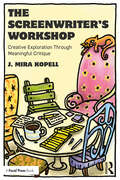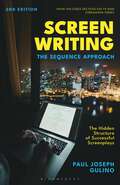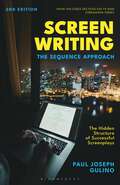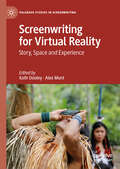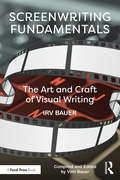- Table View
- List View
The Screenwriter's Path: From Idea to Script to Sale
by Diane LakeThe Screenwriter’s Path takes a comprehensive approach to learning how to write a screenplay—allowing the writer to use it as both a reference and a guide in constructing a script. A tenured professor of screenwriting at Emerson College in Boston, author Diane Lake has 20 years' experience writing screenplays for major studios and was a co-writer of the Academy-award winning film Frida. The book sets out a unique approach to story structure and characterization that takes writers, step by step, to a completed screenplay, and it is full of practical advice on what to do with the finished script to get it seen by the right people. By demystifying the process of writing a screenplay, Lake empowers any writer to bring their vision to the screen.
The Screenwriter's Path: From Idea to Script to Sale
by Diane LakeThe Screenwriter’s Path takes a comprehensive approach to learning how to write a screenplay—allowing the writer to use it as both a reference and a guide in constructing a script. A tenured professor of screenwriting at Emerson College in Boston, author Diane Lake has 20 years' experience writing screenplays for major studios and was a co-writer of the Academy-award winning film Frida. The book sets out a unique approach to story structure and characterization that takes writers, step by step, to a completed screenplay, and it is full of practical advice on what to do with the finished script to get it seen by the right people. By demystifying the process of writing a screenplay, Lake empowers any writer to bring their vision to the screen.
The Screenwriters Taxonomy: A Collaborative Approach to Creative Storytelling
by Eric WilliamsIn The Screenwriters Taxonomy, award-winning screenwriter and educator Eric R. Williams offers a new collaborative approach for creative storytellers to recognize, discuss and reinvent storytelling paradigms. Williams presents seven different aspects of storytelling that can be applied to any fictional narrative film—from super genre, macrogenre and microgenre to voice and point of view—allowing writers to analyze existing films and innovate on these structures in their own stories. Moving beyond film theory, Williams describes how this roadmap for creative decision making can relate to classics like Sunset Boulevard, The Wizard of Oz and Butch Cassidy and the Sundance Kid as well as such diverse modern favorites like 12 Years a Slave, Anomalisa and Shrek.
The Screenwriters Taxonomy: A Collaborative Approach to Creative Storytelling
by Eric WilliamsIn The Screenwriters Taxonomy, award-winning screenwriter and educator Eric R. Williams offers a new collaborative approach for creative storytellers to recognize, discuss and reinvent storytelling paradigms. Williams presents seven different aspects of storytelling that can be applied to any fictional narrative film—from super genre, macrogenre and microgenre to voice and point of view—allowing writers to analyze existing films and innovate on these structures in their own stories. Moving beyond film theory, Williams describes how this roadmap for creative decision making can relate to classics like Sunset Boulevard, The Wizard of Oz and Butch Cassidy and the Sundance Kid as well as such diverse modern favorites like 12 Years a Slave, Anomalisa and Shrek.
The Screenwriter’s Workshop: Creative Exploration Through Meaningful Critique
by J. Mira KopellThrough a series of carefully designed writing workshops, this book guides the screenwriter through the messy creativity of screenwriting. Drawing on over 20 years’ experience facilitating screenwriting workshops, author J. Mira Kopell provides readers with a path to screenwriting that makes space for reflection, critique, and exploration. Structured around five specific writing assignments, each assignment supports the writer forward incrementally by focusing on a specific set of craft elements needed to then move them on to the next. A key value of the assignments is that they are not exercises but steps in the development of the writer's own screenplay. By using this book, readers can both receive meaningful feedback on their own project and learn to give insightful, focused critiques of their fellow writer’s work. Rather than offering craft as a “to-do” list that promises successful scripts, this book reimagines craft as “tools not rules,” empowering a writer to let their unique story dictate choices in order to support their work and honor their own voice. This book is ideal for students and lecturers of screenwriting, groups of writers looking to form their own workshops, and aspiring professionals wanting to develop their craft.
The Screenwriter’s Workshop: Creative Exploration Through Meaningful Critique
by J. Mira KopellThrough a series of carefully designed writing workshops, this book guides the screenwriter through the messy creativity of screenwriting. Drawing on over 20 years’ experience facilitating screenwriting workshops, author J. Mira Kopell provides readers with a path to screenwriting that makes space for reflection, critique, and exploration. Structured around five specific writing assignments, each assignment supports the writer forward incrementally by focusing on a specific set of craft elements needed to then move them on to the next. A key value of the assignments is that they are not exercises but steps in the development of the writer's own screenplay. By using this book, readers can both receive meaningful feedback on their own project and learn to give insightful, focused critiques of their fellow writer’s work. Rather than offering craft as a “to-do” list that promises successful scripts, this book reimagines craft as “tools not rules,” empowering a writer to let their unique story dictate choices in order to support their work and honor their own voice. This book is ideal for students and lecturers of screenwriting, groups of writers looking to form their own workshops, and aspiring professionals wanting to develop their craft.
Screenwriting: The Sequence Approach
by Professor Paul Joseph GulinoA substantial update of the previous edition, Screenwriting: The Sequence Approach deconstructs recent feature films and offers a new section analysing popular television series.A proven screenwriting method in emotionally engaging an audience, the sequence approach emphasises the underlying motives of each story plot to better convey its relation to the work as a whole. In this expanded second edition, Paul Gulino includes analyses of recent noteworthy films and serial dramas, such as Parasite, Barry and Breaking Bad, with an eye to how they manage audience attention, convey vital information and deliver their emotional payloads. The aim of the book is to help writers move readily from the feature film to the serial form, mastering both. It is perfect for both beginning writers and those with experience in the feature screenplay form.
Screenwriting: The Sequence Approach
by Professor Paul Joseph GulinoA substantial update of the previous edition, Screenwriting: The Sequence Approach deconstructs recent feature films and offers a new section analysing popular television series.A proven screenwriting method in emotionally engaging an audience, the sequence approach emphasises the underlying motives of each story plot to better convey its relation to the work as a whole. In this expanded second edition, Paul Gulino includes analyses of recent noteworthy films and serial dramas, such as Parasite, Barry and Breaking Bad, with an eye to how they manage audience attention, convey vital information and deliver their emotional payloads. The aim of the book is to help writers move readily from the feature film to the serial form, mastering both. It is perfect for both beginning writers and those with experience in the feature screenplay form.
Screenwriting For Dummies
by Laura SchellhardtWrite a great script and get it into the hands of the Hollywood players! So you want to be a screenwriter? Whether you want to write a feature film or a TV script or adapt your favorite book, this friendly guide gives you expert advice in everything from creating your story and developing memorable characters to formatting your script and selling it to the studios. You get savvy industry tips and strategies for getting your screenplay noticed! The screenwriting process from A to Z -- from developing a concept and thinking visually to plotline, conflicts, pacing, and the conclusion Craft living, breathing characters -- from creating the backstory to letting your characters speak to balancing dialogue with action Turn your story into a script -- from developing an outline and getting over writer's block to formatting your screenplay and handling rewrites Prepare for Hollywood -- from understanding the players and setting your expectations to polishing your copy and protecting your work Sell your script to the industry -- from preparing your pitch and finding an agent to meeting with executives and making a deal Open the book and find: The latest on the biz, from entertainment blogs to top agents to box office jargon New story examples from recently released films Tips on character development, a story's time clock, dramatic structure, and dialogue New details on developing the nontraditional screenplay -- from musicals to animation to high dramatic style Expanded information on adaptation and collaboration, with examples from successful screenwriting duos
Screenwriting For Dummies
by Laura SchellhardtWrite a great script and get it into the hands of the Hollywood players! So you want to be a screenwriter? Whether you want to write a feature film or a TV script or adapt your favorite book, this friendly guide gives you expert advice in everything from creating your story and developing memorable characters to formatting your script and selling it to the studios. You get savvy industry tips and strategies for getting your screenplay noticed! The screenwriting process from A to Z -- from developing a concept and thinking visually to plotline, conflicts, pacing, and the conclusion Craft living, breathing characters -- from creating the backstory to letting your characters speak to balancing dialogue with action Turn your story into a script -- from developing an outline and getting over writer's block to formatting your screenplay and handling rewrites Prepare for Hollywood -- from understanding the players and setting your expectations to polishing your copy and protecting your work Sell your script to the industry -- from preparing your pitch and finding an agent to meeting with executives and making a deal Open the book and find: The latest on the biz, from entertainment blogs to top agents to box office jargon New story examples from recently released films Tips on character development, a story's time clock, dramatic structure, and dialogue New details on developing the nontraditional screenplay -- from musicals to animation to high dramatic style Expanded information on adaptation and collaboration, with examples from successful screenwriting duos
Screenwriting For Dummies
by Laura SchellhardtSuspend your disbelief—you can make it as a screenwriter Behind every blockbuster film and binge-worthy show, there’s a screenwriter—and that writer could be you! Turn your brainstorming sessions into dynamic scripts with the help of Screenwriting For Dummies. Create believable worlds with relatable characters, gripping dialogue, and narrative structures that will keep even the showbiz bigwigs on the edge of their seats. Once you’ve polished your product, it’s time to bring it to market. This book is full of advice that will help you get eyes on your screenplays so you can sell your work and find success as a screenwriter. From web series to movie musicals to feature films, this book shows you how to develop and hone your craft. Learn to think like a screenwriter and turn story ideas into visually driven, relatable scripts that will get noticed Study the elements of a story, like plot structure (beginning, middle, and end) and characterization (wait, who’s that, again?) Hop over the hurdle of writer’s block, and tackle other obstacles that stand in the way of your scriptwriting career Get insider insight into finding an agent and meeting with studio execs, plus alternative markets for your finished work This updated edition covers the latest trends and opportunities—and there are lots of them—for today’s writers. Let Dummies help you map out your story and put your script on the road to production. Thank us when your work goes viral!
Screenwriting For Dummies
by Laura SchellhardtSuspend your disbelief—you can make it as a screenwriter Behind every blockbuster film and binge-worthy show, there’s a screenwriter—and that writer could be you! Turn your brainstorming sessions into dynamic scripts with the help of Screenwriting For Dummies. Create believable worlds with relatable characters, gripping dialogue, and narrative structures that will keep even the showbiz bigwigs on the edge of their seats. Once you’ve polished your product, it’s time to bring it to market. This book is full of advice that will help you get eyes on your screenplays so you can sell your work and find success as a screenwriter. From web series to movie musicals to feature films, this book shows you how to develop and hone your craft. Learn to think like a screenwriter and turn story ideas into visually driven, relatable scripts that will get noticed Study the elements of a story, like plot structure (beginning, middle, and end) and characterization (wait, who’s that, again?) Hop over the hurdle of writer’s block, and tackle other obstacles that stand in the way of your scriptwriting career Get insider insight into finding an agent and meeting with studio execs, plus alternative markets for your finished work This updated edition covers the latest trends and opportunities—and there are lots of them—for today’s writers. Let Dummies help you map out your story and put your script on the road to production. Thank us when your work goes viral!
Screenwriting for Micro-Budget Films: Tips, Tricks and Hacks for Reverse Engineering Your Screenplay
by David J GreenbergScreenwriting for micro-budget films can present its own challenges and this book takes the reader through all the considerations that need to be made to write an effective screenplay for a low-budget film. Drawing on his own experience, case studies from films such as Primer, Coherence and Reservoir Dogs, as well as the perspectives of working screenwriters such as Joe Swanberg and Alex Ross-Perry, Greenberg explores common pitfalls screenwriters face and suggests practical solutions. This book lays the groundworks of the realities of low-budget filmmaking and also talks through the practical aspects, such as story structure and genre considerations. Greenberg makes the process of writing a screenplay for a low-budget film accessible and creative, allowing student and independent filmmakers to tailor their writing for their films. This book is ideal for aspiring screenwriters, independent filmmakers and students of screenwriting.
Screenwriting for Micro-Budget Films: Tips, Tricks and Hacks for Reverse Engineering Your Screenplay
by David J GreenbergScreenwriting for micro-budget films can present its own challenges and this book takes the reader through all the considerations that need to be made to write an effective screenplay for a low-budget film. Drawing on his own experience, case studies from films such as Primer, Coherence and Reservoir Dogs, as well as the perspectives of working screenwriters such as Joe Swanberg and Alex Ross-Perry, Greenberg explores common pitfalls screenwriters face and suggests practical solutions. This book lays the groundworks of the realities of low-budget filmmaking and also talks through the practical aspects, such as story structure and genre considerations. Greenberg makes the process of writing a screenplay for a low-budget film accessible and creative, allowing student and independent filmmakers to tailor their writing for their films. This book is ideal for aspiring screenwriters, independent filmmakers and students of screenwriting.
Screenwriting for Profit: Writing for the Global Marketplace
by Andrew StevensThis book teaches readers how global trends define the marketplace for saleable screenplays in key international territories as well as the domestic market. Veteran writer, producer, and director Andrew Stevens gives you the insider edge you need to write for the global marketplace, sharing his decades of experience producing and financing everything from micro-budget independent films to major studio releases. In leveraging Stevens’ comprehensive experience, you will learn how to determine specific subject matter, genre, and story elements to make the most of international sales trends, and harness the power of these insider strategies to craft a screenplay that is poised to sell.
Screenwriting for Profit: Writing for the Global Marketplace
by Andrew StevensThis book teaches readers how global trends define the marketplace for saleable screenplays in key international territories as well as the domestic market. Veteran writer, producer, and director Andrew Stevens gives you the insider edge you need to write for the global marketplace, sharing his decades of experience producing and financing everything from micro-budget independent films to major studio releases. In leveraging Stevens’ comprehensive experience, you will learn how to determine specific subject matter, genre, and story elements to make the most of international sales trends, and harness the power of these insider strategies to craft a screenplay that is poised to sell.
Screenwriting for Virtual Reality: Story, Space and Experience (Palgrave Studies in Screenwriting)
by Kath Dooley Alex MuntThis book is focused on screenwriting and development for virtual reality (VR). It explores a diverse range of creative approaches to the writing and screen development of VR stories and immersive audience experiences. Contributions from scholars and practitioners combine conceptual and practically orientated approaches for creating fictional and documentary media VR stories. The book evaluates, challenges and adapts existing screenwriting models and practices for immersive storytelling and grapples with the future of storytelling in the era of sophisticated computer visualization, AI and the online social metaverse. The book proposes new VR storytelling models, identifies altered relationships between creators, screen works and their audiences and demonstrates how interdisciplinary practices will be core to the future of screen storytelling.
Screenwriting from the Inside Out: Think and Write like a Creative
by Margaret McVeighThis book provides aspiring screenwriters with a practical and informed way to learn how to think and write like a “creative”. It stands apart from, yet complements, other screenwriting “how to” books by connecting the transdisciplinary academic fields of screenwriting, film studies and cognitive psychology and neuroscience. Using a stepped approach, it shows the writer how to understand that how we think, shapes what we write, so that we may write better.
Screenwriting Fundamentals: The Art and Craft of Visual Writing
by Irv BauerScreenwriting Fundamentals: The Art and Craft of Visual Writing takes a step-by-step approach to screenwriting, starting with a blank page and working through each element of the craft. Written in an approachable anecdote-infused style that’s full of humor, Bauer shows the writer how to put the pieces together, taking the process of screenwriting out of the cerebral and on to the page. Part One of the book covers character, location, time-frame and dialogue, emphasizing the particularity in writing for a visual medium. Part Two of the book focuses on the narrative aspect of screenwriting. Proceeding incrementally from the idea and story outline, through plotting and writing the treatment, the workshop-in-a-book concludes with writing the First Draft. A unique emphasis on the visual elements of storytelling because the camera is always present—the screenplay must act as a guide for the director and the editor. A "workshop in a book" approach that walks the reader step-by-step through a screenplay—focusing on character, location, time frame, visual components, and transitions—with plenty of exercises that generate material for the narrative writing process. A process-oriented approach, combined with a lighthearted tone and approachable style, that allows the reader to ease into the daunting task of writing a First Draft and takes them all the way through to the end— First Draft in hand.
Screenwriting Fundamentals: The Art and Craft of Visual Writing
by Irv BauerScreenwriting Fundamentals: The Art and Craft of Visual Writing takes a step-by-step approach to screenwriting, starting with a blank page and working through each element of the craft. Written in an approachable anecdote-infused style that’s full of humor, Bauer shows the writer how to put the pieces together, taking the process of screenwriting out of the cerebral and on to the page. Part One of the book covers character, location, time-frame and dialogue, emphasizing the particularity in writing for a visual medium. Part Two of the book focuses on the narrative aspect of screenwriting. Proceeding incrementally from the idea and story outline, through plotting and writing the treatment, the workshop-in-a-book concludes with writing the First Draft. A unique emphasis on the visual elements of storytelling because the camera is always present—the screenplay must act as a guide for the director and the editor. A "workshop in a book" approach that walks the reader step-by-step through a screenplay—focusing on character, location, time frame, visual components, and transitions—with plenty of exercises that generate material for the narrative writing process. A process-oriented approach, combined with a lighthearted tone and approachable style, that allows the reader to ease into the daunting task of writing a First Draft and takes them all the way through to the end— First Draft in hand.
Screenwriting in a Digital Era (Palgrave Studies in Screenwriting)
by Kathryn MillardScreenwriting in a Digital Era examines the practices of writing for the screen from early Hollywood to the new realism. Looking back to prehistories of the form, Kathryn Millard links screenwriting to visual and oral storytelling around the globe, and explores new methods of collaboration and authorship in the digital environment.
Screenwriting is Rewriting: The Art and Craft of Professional Revision
by Jack Epps Jr.If there is one skill that separates the professional screenwriter from the amateur, it is the ability to rewrite successfully. From Jack Epps, Jr., the screenwriter of Top Gun, Dick Tracy, and The Secret of My Success, comes a comprehensive guide that explores the many layers of rewriting. In Screenwriting is Rewriting, Epps provides a practical and tested approach to organizing notes, creating a game plan, and executing a series of focused passes that address the story, character, theme, structure, and plot issues. Included are sample notes, game plans, and beat sheets from Epps' work on films such as Sister Act and Turner and Hooch. Also featured are exclusive interviews with Academy Award® winning screenwriters Robert Towne (Chinatown) and Frank Pierson (Dog Day Afternoon), along with Academy Award® nominee Susannah Grant (Erin Brockovich).
Screenwriting is Rewriting: The Art and Craft of Professional Revision
by Jack Epps Jr.If there is one skill that separates the professional screenwriter from the amateur, it is the ability to rewrite successfully. From Jack Epps, Jr., the screenwriter of Top Gun, Dick Tracy, and The Secret of My Success, comes a comprehensive guide that explores the many layers of rewriting. In Screenwriting is Rewriting, Epps provides a practical and tested approach to organizing notes, creating a game plan, and executing a series of focused passes that address the story, character, theme, structure, and plot issues. Included are sample notes, game plans, and beat sheets from Epps' work on films such as Sister Act and Turner and Hooch. Also featured are exclusive interviews with Academy Award® winning screenwriters Robert Towne (Chinatown) and Frank Pierson (Dog Day Afternoon), along with Academy Award® nominee Susannah Grant (Erin Brockovich).
Screenwriting Poetics and the Screen Idea (Palgrave Studies in Screenwriting)
by I. MacDonald Ian W. MacdonaldA new, original investigation into how screenwriting works; the practices, creative 'poetics' and texts that serve the screen idea. Using a range of film, media and creative theories, it includes new case studies on the successful ITV soap Emmerdale, Hitchcock's first major screenwriter and David Lean's unfinished film, Nostromo.
Screw Compressors: Mathematical Modelling and Performance Calculation
by Nikola Stosic Ian Smith Ahmed KovacevicAlthoughtheprinciplesofoperationofhelicalscrewmachines,ascompressors or expanders, have been well known for more than 100 years, it is only during the past 30 years that these machines have become widely used. The main reasons for the long period before they were adopted were their relatively poor e?ciency and the high cost of manufacturing their rotors. Two main developments led to a solution to these di?culties. The ?rst of these was the introduction of the asymmetric rotor pro?le in 1973. This reduced the bl- hole area, which was the main source of internal leakage by approximately 90%, and thereby raised the thermodynamic e?ciency of these machines, to roughly the same level as that of traditional reciprocating compressors. The second was the introduction of precise thread milling machine tools at - proximately the same time. This made it possible to manufacture items of complex shape, such as the rotors, both accurately and cheaply. From then on, as a result of their ever improving e?ciencies, high rel- bility and compact form, screw compressors have taken an increasing share of the compressor market, especially in the ?elds of compressed air production, and refrigeration and air conditioning, and today, a substantial proportion of compressors manufactured for industry are of this type. Despite, the now wide usage of screw compressors and the publication of many scienti?c papers on their development, only a handful of textbooks have been published to date, which give a rigorous exposition of the principles of their operation and none of these are in English.


